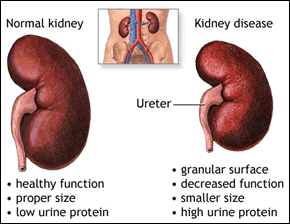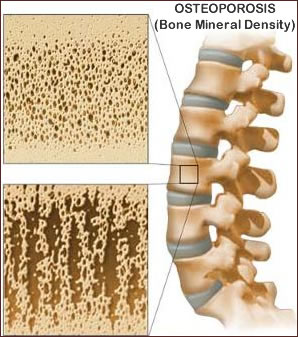Tenofovir
(Viread, also in the Truvada
and Atripla
coformulations) is highly effective in treating hepatitis
B virus (HBV), but it can potentially cause kidney problems
in susceptible individuals and may lead to bone loss over time.
At
the European Association for the Study of the Liver's International
Liver Congress (EASL 2011) this month
in Berlin, investigators presented findings from 2 studies of
tenofovir side effects in people treated for hepatitis B.
Kidney
Function
 Patrick
Marcellin and colleagues analyzed the effect of tenofovir on
kidney function among 675 chronic hepatitis B patients in 3
large randomized clinical trials, Gilead's Study 102, 103, and
106. The first 2 studies compared tenofovir vs adefovir (Hepsera)
for 48 weeks, then patients could continue open-label tenofovir
through 8 years. Study 106 compared tenofovir alone vs tenofovir
plus emtricitabine (Emtriva). These studies included only HIV
negative people; another analysis presented at EASL looked at
HIV/HBV coinfected patients.
Patrick
Marcellin and colleagues analyzed the effect of tenofovir on
kidney function among 675 chronic hepatitis B patients in 3
large randomized clinical trials, Gilead's Study 102, 103, and
106. The first 2 studies compared tenofovir vs adefovir (Hepsera)
for 48 weeks, then patients could continue open-label tenofovir
through 8 years. Study 106 compared tenofovir alone vs tenofovir
plus emtricitabine (Emtriva). These studies included only HIV
negative people; another analysis presented at EASL looked at
HIV/HBV coinfected patients.
Overall, about 75% of study participants were men, nearly 60%
were white, about 30% were Asian, and less than 5% were black.
The median age was 41 years and more than three-quarters were
younger than 50. Just over 40% were hepatitis B "e"
antigen (HBeAg) positive. Some patients had and some had not
previously used adefovir, a related nucleotide analog that can
also cause kidney toxicity.
With regard to other kidney risk factors, about 15% had a history
of hypertension (high blood pressure) and about 5% had diabetes.
At baseline, less than 1% had poor creatinine clearance (<
50 mL/min) and about 8% had somewhat impaired clearance (50-80
mL/min).
Researchers analyzed data collected through 144 weeks, evaluating
kidney function based on serum creatinine and estimated glomerular
filtration rate (eGFR) using the Cockcroft-Gault equation. Kidney
events were defined as either a confirmed increase in serum
creatinine by at least 0.5 mg/dL from baseline or confirmed
eGFR < 50 mL/min.
Among 426 treatment-naive patients receiving tenofovir, there
was a low incidence of kidney events through 144 weeks of treatment.
No treatment-naive study participants had confirmed eGFR <
50 mL/min; 2 patients (0.5%) had at least a 0.5 mg/dL increase
in creatinine. Results did not differ significantly between
subgroups with and without hypertension or diabetes.
Among 249 adefovir-experienced study participants, 1 person
(0.4%) had confirmed eGFR < 50 mL/min and 3 (1.2%) experienced
at least a 0.5 mg/dL increase in creatinine. Again, results
were similar for patients with and without hypertension or diabetes,
though numbers were small.
Based on these findings, the researchers concluded, "Tenofovir
monotherapy over 144 weeks was safe and well tolerated without
clinically relevant changes in renal function across a broad
range of patient populations including those with co-morbidities
typically associated with renal impairment."
Overall,
they continued, "few patients experienced a decline in
renal function." Taken together, 5 of 675 patients (0.7%)
had at least a 0.5 mg/mL increase in creatinine (including 3
with pre-existing hypertension and 1 with pre-existing diabetes).
Just 1 patient (0.1%), who had pre-existing hypertension, had
an eGFR decline to < 50mL/min.
The investigators noted, however, that the lack of a placebo
group in these long-term studies -- as opposed to a control
group that took a different potentially kidney-toxic drug --
"makes conclusions concerning the potential role of tenofovir
in decreasing renal function more difficult to assess."
Bone
Loss
 As
described in a related poster, an international team of investigators
looked at prevalence of bone problems among chronic hepatitis
B patients.
As
described in a related poster, an international team of investigators
looked at prevalence of bone problems among chronic hepatitis
B patients.
Metabolic bone disease is a known potential complication among
people with chronic liver disease. Since tenofovir has been
linked to bone loss, it would be useful to know how many people
in the hepatitis B patient population might be especially prone
to this side effect.
Gilead's Study GS-US-174-0121 randomly assigned 250 lamivudine
(Epivir-HBV)-resistant chronic hepatitis B patients to receive
either tenofovir alone or tenofovir plus emtricitabine. About
75% were men, the median age was 48 years, 60% were white, 35%
were Asian, 48% were HBeAg positive, and the average body mass
index was 25.1; less than 2% had thyroid disease or a history
of past fractures.
Study participants underwent dual energy x-ray absorptiometry
(DEXA) scans of the spine and hip prior to starting study drugs.
The researchers found that more people had reduced bone mineral
density according to baseline DEXA scans than had bone loss
reported in their medical records; 6 had osteopenia, or low
bone density, while 4 had more severe osteoporosis.
There
was some indication that duration of chronic HBV infection and
HBeAg status may contribute to greater risk of reduced bone
density, but duration of treatment with lamivudine or adefovir
did not appear to have an effect.
"In our study, baseline median Z- and T- scores [standard
measures of bone density] suggest that males and Asians have
greater reductions in bone mineral density compared to females
and non-Asians," the researchers reported.
"Our data demonstrate a higher prevalence of baseline bone
disease among patients with chronic HBV," they concluded.
"Duration of chronic HBV but not duration of treatment
appears to impact bone mineral density."
Investigator affiliations:
Marcellin et al: Hopital Beaujon, Clichy, France; Toronto Western
Hospital, University of Toronto, Toronto, Canada; Universitätsklinik
Leipzig, Leipzig, Germany; Gilead Sciences, Inc., Durham, NC;
Gilead Sciences, Inc., Foster City, CA.
Fung et al: University Health Network, Toronto General Hospital,
Toronto, Canada; Clinical Centre Vojvodina, Clinic of Infectious
Diseases, Clinical Centre of Serbia, Novi Sad, Serbia; Toronto
Western Hospital, University Health Network, Toronto, Canada;
Uludag University Medical Faculty Hospital, Bursa, Turkey; Hepatitis
Program, Vancouver Hospital, Vancouver, BC, Canada; Prof. Dr.
Matei Bals Institute for Infectious Diseases, Bucharest, Romania;
Faculty Hospital Brno and Faculty of Medicine, Masaryk University
Brno, Brno, Czech Republic; Clinical Department of Infectious
Diseases, Silesian Medical School, Chorzów, Poland; Clinic
for Infectious and Tropical Diseases, Belgrade, Serbia; Auckland
City Hospital, Auckland, New Zealand; Gilead Sciences Inc.,
Durham, NC.
4/19/11
References
P
Marcellin, EJ Heathcote, T Berg, et al. Effects of tenofovir
disoproxil fumarate on renal function in chronic HBV patients
in three global randomized studies. 46th Annual Meeting of the
European Association for the Study of the Liver (EASL 2011).
Berlin. March 30-April 3. Abstract
616.
S
Fung, M Fabri, F Wong, et al. Reduced bone mineral density derived
from dual x-ray absorptiometry assessments in patients with
chronic hepatitis B (CHB). 46th Annual Meeting of the European
Association for the Study of the Liver (EASL 2011). Berlin.
March 30-April 3. Abstract
175.
